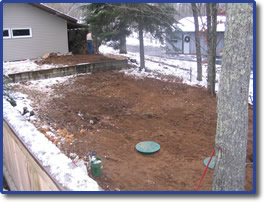Septic System Maintenance- You should conserve water whenever possible. Large volumes over short periods will flush untreated wastes into the drain field. Space out heavy uses of water such as laundry and bathing.
- Repair leaky faucets and valves. Consider replacing old toilets that use 3.5 to 5 gallons of water with the newer models that use 1.6 gallons of water.
- Keep your drains clean. Remember that only biodegradable waste should go in the septic.
- No cigarette butts, tissues, sanitary napkins, disposable diapers, coffee grounds, or cotton swabs. If it is not biodegradable it doesn't belong in the septic.
- No paints, oils, chemical drain cleaners, thinners, solvents, poisons, or pesticides. These not only kill bacteria, they may contaminate your well.
- You should never dump grease or cooking oil down the drain. Grease can harden in the tank's scum layer and then build up and block the inlet or outlet of the tank. If you melt grease and pour it down the drain it may run through the septic tank, hardening and clogging the soil pores.
- Go easy on the garbage disposal. Using this doubles the rate of solids building up in the tank. Try composting as an alternative. A-1 Septic Service does not recommend using a garbage disposal.
- Household cleaners such as disinfectants, ammonia, and bleach can kill bacteria that your septic tank needs to operate properly, therefore please use in moderation.
- Water treatment systems that back flush salt brine into the septic system may result in premature system failure. Wisconsin Plumbing Code allows surface discharge of water treatment devices.
- Keep surface water away from your septic.
- Remove trees like willows that are like "wet feet". The roots are invasive and may penetrate and damage the drain field.
- Do not drive over the septic tank or drain field, or compact soil with heavy equipment. Don't dig in the drain field or build anything over it.
- Make sure the tank is accessible to your septic company. Install risers to your tank to bring the cover above ground for easy access in harsh winter weather.
- Do not cover the tank or drain field with concrete or blacktop.
- Did you know that if you have a steel tank on your property, for your safety, you should avoid foot traffic over the tank and lid and you should consider replacing it?
Did you know your septic system could freeze?- The reason a septic may freeze has to do with lack of snow cover and sub-zero temperatures that allow the frost to penetrate into the septic system.
- Driving, walking, or any traffic on the drain field should be avoided during winter months. This causes the frost to be further pushed down into the system.
- Energy efficient gas furnaces have a release of condensation into the septic tank lines. This flow of water should be pumped out all at once and not allowed to trickle out through the lines. This slow trickle of water ices up slowly in the line causing it to freeze between the house and the tank. In a primary residence this may not be a problem, but if the home is a secondary residence and there is not enough warm water going through the line this can become a problem.
- If the drain field has frozen, the septic tank then has to be treated as a holding tank until the frost leaves the ground. The important thing here is to call and have the tank pumped before it overloads and causes the line between the tank and house to freeze as well. If this line freezes it can be steam thawed.
|
